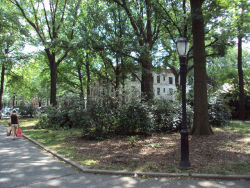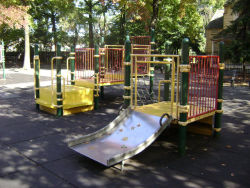Margaret I. Carman Green - Weeping Beech
Weeping Beech Park
The Weeping Beech tree that once rooted itself in this park lived for 151 years, from 1847 to 1998 -- one of the City’s few trees to be landmarked. The tree originated at a nobleman’s estate in Beersal, Belgium from whence it was transported to New York City by the efforts of one enterprising gardener. Samuel Bowne Parsons (1819-1907), a prominent horticulturalist and father of Parks Superintendant Samuel Parsons Jr. (1844-1923), obtained the seedling and planted it on the grounds of his renowned nursery. In its maturity, its branches touched the ground and re-rooted, creating a ring of offspring surrounding its immense canopy. In the years before it finally succumbed to old age, it reached sixty feet in height with a “leaf curtain” of eighty feet in diameter. Legend has it that this tree gave rise to generations of Weeping Beeches (Fagus sylvatica) in America.
To the south of where the beech once stood is Queens’ second oldest house, the Kingsland Homestead. Built by Flushing native Charles Doughty around 1785, the house acquired its name from his son-in-law, British sea captain Joseph King, who bought the home in 1801. The last of Doughty’s descendants to reside in the house were the Murrays who lived there until 1937. (Both Manhattan’s Murray Hill and Queens’ Murray Hill are named for this family.) When a subway extension threatened to destroy the house in 1923, it was moved from its foundations on 155th Street and Northern Boulevard. Endangered again by new construction in 1968, the house was transferred to its present site by the Kingsland Preservation Committee. The Queens Historical Society was formed in that year, and has had its headquarters in the house ever since.
The gambrel-roofed shingle house, which combines English and Dutch architectural styles, is a prime example of the “Long Island Half House” that was common during the post-Colonial period. It has been open to the public since 1973, providing visitors with a glimpse of Victorian life with its furnished rooms and special exhibits curated by the Queens Historical Society. Kingsland Homestead is both a New York City Landmark and a National Historic Landmark. It is owned and managed by the Queens Historical Society, and is a member of the Historic House Trust of New York City, a not-for-profit organization founded in 1989 to help the New York City Department of Parks & Recreation preserve its collection of historic houses located in city parks. The house was completely rehabilitated and conserved between 1988 and 1996 with funding provided by the New York State Environmental Bond Act and the Borough President of Queens.
This parkland was first acquired by Parks in 1925, and was originally known as Jackson Park due to its location on Jackson Avenue (now called Northern Boulevard). The playground opened on October 10, 1950 and a second parcel was added in 1951. The latter portion was named Carman Green in 1976 for Margaret I. Carman (1890-1976), a Flushing High School teacher who created the Flushing Freedom Trail to link the area’s rich heritage through its landmarks.
Adjacent to the park is the oldest landmark in the area, the Bowne House, located at Bowne Street and 38th Avenue. It was built by John Bowne in 1661 and, as perhaps the oldest existing house of worship in America, is celebrated as a “national shrine to religious freedom.” From Bowne’s courageous defense of the Quakers’ right to worship, to Kingsland Homestead in the post-revolutionary period, to the Weeping Beech, a reminder of the nurseries that flourished in Flushing up through the 19th century, this cluster of landmarks unites three centuries of Queens’ history.
Check out your park's Vital Signs
Clean & Safe
Green & Resilient
Empowered & Engaged Users
Share your feedback or learn more about how this park is part of a
Vital Park System



